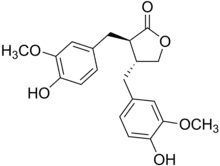Matairesinol
Matairesinol is an organic compound. It is classified as a lignan, i.e., a type of phenylpropanoid. It is present in some cereals, e.g. rye, and together with Secoisolariciresinol, has attracted much attention for its beneficial nutritional effects.[2]
 | |
| Names | |
|---|---|
| IUPAC name
(8β,8′α)-4,4′-Dihydroxy-3,3′-dimethoxylignano-9,9′-lactone | |
| Systematic IUPAC name
(3R,4R)-3,4-Bis[(4-hydroxy-3-methoxyphenyl)methyl]oxolan-2-one | |
| Other names
(αR,βR)-α,β-Bis(4-hydroxy-3-methoxybenzyl)butyrolactone | |
| Identifiers | |
3D model (JSmol) |
|
| ChEBI | |
| ChEMBL | |
| ChemSpider | |
| DrugBank | |
| KEGG | |
PubChem CID |
|
| UNII | |
CompTox Dashboard (EPA) |
|
| |
| |
| Properties | |
| C20H22O6 | |
| Molar mass | 358.390 g·mol−1 |
Except where otherwise noted, data are given for materials in their standard state (at 25 °C [77 °F], 100 kPa).
Infobox references | |
Metabolism
The plant lignans are precursors of the enterolignans (mammalian lignans).[3] A number of plant lignans are metabolized to the enterolignans (enterodiol and enterolactone) that can potentially reduce the risk of certain cancers and cardiovascular diseases.[4]
Biomedical considerations
Although some studies attribute disease preventative (cardio-protective and hormone associated cancers like breast cancer) benefits of lignans, the results are inconclusive.[5] Matairesinol has been found to act as an agonist of the adiponectin receptor 1 (AdipoR1).[6]
References
- Matairesinol at Sigma-Aldrich
- Seibel, Wilfried; Kim Chung, Okkyung; Weipert, Dorian; Park, Seok-Ho (2006). "Cereals". Ullmann's Encyclopedia of Industrial Chemistry. Weinheim: Wiley-VCH. doi:10.1002/14356007.a06_093.pub2.
- Niemeyer HB, Honig DM, Kulling SE, Metzler M (October 2003). "Studies on the metabolism of the plant lignans secoisolariciresinol and matairesinol". J. Agric. Food Chem. 51 (21): 6317–25. doi:10.1021/jf030263n. PMID 14518962.
- Milder IE, Arts IC, van de Putte B, Venema DP, Hollman PC (March 2005). "Lignan contents of Dutch plant foods: a database including lariciresinol, pinoresinol, secoisolariciresinol and matairesinol". Br. J. Nutr. 93 (3): 393–402. doi:10.1079/BJN20051371. PMID 15877880.
- Linus Pauling Institute at Oregon State University
- Sun Y, Zang Z, Zhong L, Wu M, Su Q, Gao X, Zan W, Lin D, Zhao Y, Zhang Z (2013). "Identification of adiponectin receptor agonist utilizing a fluorescence polarization based high throughput assay". PLOS ONE. 8 (5): e63354. Bibcode:2013PLoSO...863354S. doi:10.1371/journal.pone.0063354. PMC 3653934. PMID 23691032.